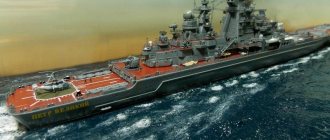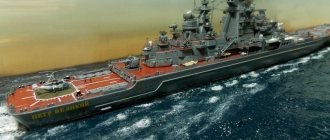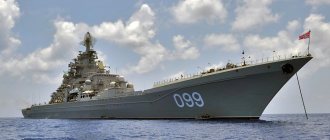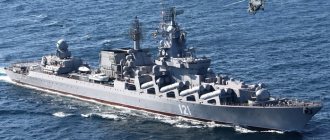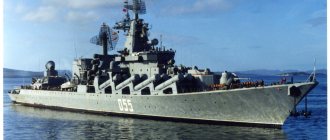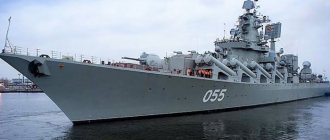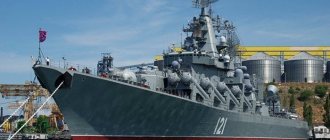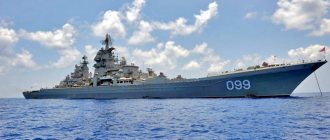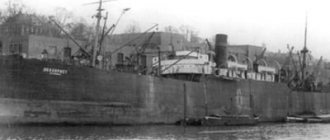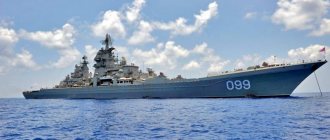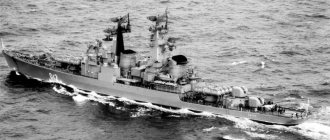The cruiser "Peter the Great" is the fourth and only heavy nuclear-powered missile cruiser (TARKR) of the third generation of Project 1144 "Orlan" in service. The main purpose is to destroy enemy aircraft carrier groups.
Video of the cruiser "Peter the Great"
Designer - Northern Design Bureau. The cruiser was laid down in 1986 on the slipway of the Baltic Shipyard (when laid down it was called Kuibyshev, then Yuri Andropov). On April 25, 1989 it was launched. Renamed “Peter the Great” by decree of the President of the Russian Federation on April 22, 1992. In 1998 he joined the fleet.
Industrial enterprises carry out constant work on the cruiser; they make it possible to carry out trips to sea for eleven years in a row without putting the ship into average factory repairs. The TsKB-designer withdrew from work on the ship, considering it unprofitable. Before the renaming, “Peter the Great” bore tail number 183, now tail number is 099.
Design
It is the world's largest operational non-carrier attack combat ship as of 2015.
Basic performance characteristics
- Length: 262 m.
- Width: 28.5 m.
- Height from the main plane: 59 m.
- Draft: 10.3 m.
- Standard displacement: 23,750 tons.
- Total displacement: 25,860 tons.
- Power plant: 2 nuclear reactors of the KN-3 type (300 MW), 2 auxiliary boilers, two turbines of 70 thousand liters each. With. (total 140 thousand hp), 4 power plants with a total capacity of 18 thousand kW, 4 steam turbine generators with a capacity of 3000 kW, 4 gas turbine generators of 1500 kW each, two propeller shafts.
- Speed: 31 knots (over 57 km/h).
- Navigation autonomy - 60 days for food and supplies, 3 years (at a nuclear reactor - unlimited) for fuel.
Hull and superstructure design
The length of the ship's 49 corridors is more than 20 kilometers. The ship has 6 decks, 8 tiers. The height of the foremast from the level of the main plane is 59 meters.
Power plant
The cruiser's powerful nuclear power plant allows it to reach a speed of 32 knots (60 km/h) and is designed to operate for 50 years. For comparison: the cruiser “Peter the Great” is capable of providing electricity and heat to a city of 150-200 thousand inhabitants.
The crew of the cruiser "Peter the Great"
The cruiser's crew is 1035 people (105 officers, 130 midshipmen, 800 sailors). They are located in 1,600 rooms of the ship, including 140 single and double cabins for officers and midshipmen, 30 cockpits for sailors and petty officers (for 8-30 people each), 220 vestibules. The crew has 15 showers, two baths, a sauna with a 6x2.5 m swimming pool, a two-level medical block with isolation hospitals, a pharmacy, X-ray and dental rooms, an outpatient clinic, an operating room, a gym equipped with exercise equipment, three wardrooms for midshipmen and officers and admirals, a lounge with billiards and a piano. There is also an in-ship television studio and 12 household televisions in cabins and cockpits, in addition to 30 monitors for viewing programs that are broadcast on the ship's cable networks.
Armament of the cruiser "Peter the Great"
TARKR "Peter the Great" is one of the most modern and powerful ships of the Russian Navy and one of the most powerful attack ships in the world. The ship has the ability to engage large surface targets and protect naval formations from attacks from the air and enemy submarines. It has an unlimited cruising range and is equipped with strike cruise missiles capable of hitting targets at a distance of up to 550 kilometers.
TARKR "Peter the Great" is equipped with the Granit anti-ship missile system (developed by NPO Mashinostroyenia), equipped with 20 SM-233 launchers with advanced high-precision P-700 Granit anti-ship cruise missiles installed under the upper deck, with an elevation angle of 60 degrees. The length of the rocket is 10 m, the caliber is 0.85 m, the launch weight is 7 tons. The warhead is a monoblock in nuclear (500 kt), conventional (750 kg of explosive) equipment or a fuel-air warhead (volume explosion). The firing range is 700 km, the flight speed is 1.6-2.5 M. The missiles have a multi-variant target attack program, increased noise immunity and are designed to strike group targets. When firing salvos, one of them follows at a high altitude to increase the detection range of the enemy, exchanging information with the others, which literally creep above the surface of the water. If the leader missile is destroyed, one of the slave missiles automatically takes its place.
Over-the-horizon target designation and guidance can be carried out by a Tu-95RTs aircraft, a Ka-25Ts helicopter or a space reconnaissance and target designation system.
The ship is equipped with the Reef S-300F anti-aircraft complex, has 12 launchers and 96 vertical launch missiles.
There is also an autonomous shipborne anti-aircraft system "Dagger". Each below-deck drum-type launcher has 8 single-stage solid-fuel remote-controlled missiles 9M330-2, the total supply is 128 missiles.
The cruiser is armed with the Kortik anti-aircraft missile and artillery system, which provides self-defense against a number of “precision” weapons, including anti-ship and anti-radar missiles, aerial bombs, airplanes and helicopters, and small ships. Each installation has two 30-mm six-barreled artillery mounts AK-630M1-2 with two AO-18 assault rifles according to the Gatling scheme with a total rate of fire of 10,000 rpm and two blocks of 4 two-stage 9M311 (SA-N-11) missiles with fragmentation rod warhead and proximity fuse. There are 16 more missiles in the turret compartment. The missiles are unified with the 2S6 Tunguska missile. The control system of the Kortik air defense system consists of radar and television systems interconnected using elements of artificial intelligence. Two Kortik air defense systems are located in the bow of the ship on both sides of the Granit launcher, and four others are located in the aft part of the main superstructure.
In addition, the cruiser "Peter the Great" is equipped with 130-mm multi-purpose twin artillery mounts "AK-130" (barrel length - 70 calibers, 840 shells) with a firing range of up to 25 km. Rate of fire - from 20 to 80 rounds per minute. The mass of the high-explosive fragmentation projectile is 27 kg, it has impact, remote and radio fuses. The ready-to-fire ammunition capacity is 180 rounds. The MP-184 fire control system allows for simultaneous tracking and firing of two targets.
The cruiser is also armed with two anti-submarine (5 launchers per side) 533-mm RPK-6M Vodopad missile-torpedo systems, the missile-torpedoes of which are capable of hitting enemy submarines at ranges of up to 60 km. The small-sized torpedo UMGT-1 is used as the warhead. The missile dives into the water, takes off into the air and delivers the torpedo to the target area, and then the word goes to UMGT-1, which dives into the water again.
To combat enemy torpedoes, the cruiser "Peter the Great" has an anti-torpedo complex RKPTZ-1M "Udav-1M" (10 guide tubes, automatic conveyor reloading, reaction time - 15 seconds, maximum range - 3000 m, minimum - 100 m, missile weight - 233 kg). Jet bomb launchers on the Peter the Great are located as follows: one ten-tube RBU-12000 (firing range - 12 km, projectile weight - 80 kg) installed in the bow of the ship on a turntable, two six-tube RBU-1000 Smerch-3 ( range - 1000 m, projectile weight - 55 kg) - in the aft part on the upper deck on both sides. General ship-wide countermeasures include two twin 150-mm PK-14 launchers (a complex of projectile jammers), anti-electronic decoys, decoys, as well as a towed decoy torpedo target with a powerful noise generator.
Two Ka-27 anti-submarine helicopters are based on board the cruiser.
The radar systems of the TARKR "Peter the Great" REP/EW include 16 stations of three types. General ship tracking, tracking and target designation facilities consist of two space communication stations (SATSOM), four space navigation stations (SATPAU) and four special electronic stations. The air-surface situation is monitored by all-weather three-dimensional Fregat-MAE radars, which detect targets at ranges of more than 300 km and altitudes of up to 30 km.
The cruiser also has three navigation stations, four radio-electronic fire control systems for on-board weapons, helicopter flight controls and a “friend or foe” identification system.
The ship's sonar system includes a sonar with a hull antenna for searching and detecting submarines at low and medium frequencies and a towed automated sonar system with an antenna of variable diving depth (150-200 m) at medium frequencies.
After modernization in 2019-2022. The cruiser's armament will include hypersonic anti-ship missiles "Zircon", supersonic universal medium-range anti-ship missiles P-800 "Oniks", and cruise missiles "Caliber".
History of construction
The plant began construction of the last ship of Project 1144 in 1986. After 10 years, the cruiser left for sea trials. In accordance with the state testing plan, the running program was carried out in the harsh conditions of the Arctic.
Service history
On October 27, 1996, a steam line under pressure of 35 atmospheres and a dry steam temperature of +300 °C ruptured in the bow engine and boiler room. Two sailors and three workers of the delivery crew were killed. When investigating the cause, it was revealed that the burst pipe was installed in 1989 and the thickness and grade of steel did not correspond to the design. In March 1998, the nuclear-powered cruiser was transferred to the fleet under the name "Peter the Great".
Despite the fact that the warranty period of the Baltic Shipyard has expired, the company, for the first time in world practice, continues to carry out maintenance of the cruiser. The Navy command made this decision due to the fact that the ship’s personnel did not have sufficient skills to maintain and operate the cruiser’s equipment. Under the terms of the state contract, the Baltic Shipyard will continue to provide technical support for Peter the Great until the first scheduled repair in 2008.
Helicopter descent into the hold on board the cruiser "Peter the Great"
On the night of August 12-13, 2000, the cruiser was the first to discover and drop anchor at the site of the Kursk APRK disaster, awaiting rescue ships. The cruiser also patrolled the area during the rise of the Kursk.
Participated in the filming of the film “72 Meters” (2004).
In October 2008, it passed through the Strait of Gibraltar into the Mediterranean Sea.
In December 2008, he took part in the joint naval exercises of the Russian Federation and Venezuela “VENRUS-2008”, which began on December 1, 2008 in the Caribbean Sea. The detachment also includes the anti-submarine ship Admiral Chabanenko.
According to RIA Novosti, on February 13, 2009, the cruiser detained 3 Somali pirate ships in the Gulf of Aden. Some analysts note that catching small pirate ships is not the task for which a heavy nuclear cruiser is designed.
On March 30, 2010, the TARKR "Peter the Great" left Severomorsk to conduct exercises in the far sea zone (the senior voyage was Captain 1st Rank S. Yu. Zhuga), which marked the beginning of the largest Russian Navy exercises in the world's oceans in recent years. The cruiser must pass through the Atlantic, Indian and Pacific oceans and arrive in the Far East, where exercises dedicated to the 150th anniversary of Vladivostok took place from June 28 to July 8, 2010. The campaign of “Peter the Great” will last until November 2010. On April 4, the cruiser successfully passed through the English Channel, on April 7, together with the Baltic Fleet patrol ship Yaroslav the Wise, through the Strait of Gibraltar and entered the Mediterranean Sea, after which the ships separated. On April 13-14, “Peter the Great” called at the Syrian port of Tartus. On April 16, it passed through the Suez Canal into the Red Sea, proceeding further to the Gulf of Aden and the Indian Ocean, sailing together with the missile cruiser "Moscow" of the Black Sea Fleet.
140,000 miles in 16 years.
Engine and boiler room of the nuclear cruiser "Peter the Great"
On July 28, 2012, the heavy nuclear-powered missile cruiser "Peter the Great" was awarded the Order of Nakhimov by Decree of the President of the Russian Federation "for courage, dedication and high professionalism shown by the ship's personnel when carrying out combat missions of the command." On January 10, 2013, President V.V. Putin, during his visit to Severomorsk, presented the award to the commander of the cruiser. The order's naval flag with the image of the Order of Nakhimov was raised on the ship.
From September 3, 2013 to October 1 of the same year, he made an Arctic voyage at the head of a detachment of ships and vessels of the Northern Fleet, covering 4,000 miles.
It will undergo repairs and deep modernization in 2018-2021, after completion of work on the same type “Admiral Nakhimov”.
Commanders of the cruiser "Peter the Great"
- Ovchinnikov Nikolai Alekseevich - captain 2nd rank (in June 1989, after graduating from the A.A. Grechko Military Academy, he was appointed the first commander of the cruiser "Yuri Andropov". In April 1989, he took part in the launch of the cruiser from the stocks into the water. Captain 2nd rank Nikolai Alekseevich Ovchinnikov personally received the seal of the military unit of military unit 09906 and began forming the ship's crew in the Pacific Fleet. The senior mate on the cruiser was Evgeniy Nikolaevich Dobryshev. In January 1990, captain 2nd rank N.A. Ovchinnikov was assigned to the active heavy nuclear-powered missile cruiser pr 1144 "Frunze". For some reason, the name of the first actual commander of the TARKR "Peter the Great", who previously had the name "Yuri Andropov", captain 2nd rank Nikolai Alekseevich Ovchinnikov, is not listed in the "Historical Journal of the Cruiser").
- Dobryshev Evgeniy Nikolaevich - captain 1st rank (First Commander of the Cruiser according to the Historical Journal, under his leadership the formation of the crew in Vladivostok, the completion of the ship in St. Petersburg and the transition to the Northern Fleet took place).
- Vasiliev Sergey Igorevich - captain 1st rank (under his leadership, state tests were passed and the flag was raised).
- Kasatonov Vladimir Lvovich - rear admiral (March 2000-July 2005), now vice admiral, chief of staff of the Pacific Fleet.
- Yakushev Vladimir Anatolyevich - captain 1st rank.
- Menkov Felix Vladimirovich - captain 1st rank.
- Malakhovsky Vladislav Vladimirovich - captain 1st rank.
First "Kirov"
Sergei Kirov, of course, was not a naval commander, but in the young USSR the choice of famous names that one would not be ashamed to name a warship with was small.
However, the previous combat "Kirov" was able to cover this name with well-deserved glory. It was a light cruiser, built in the second half of the 30s according to a design purchased in Italy.
Armed with nine 180 mm guns, he took part in the defense of Tallinn, and after moving to Kronstadt, until the end of the war he fired at German forces blockading Leningrad.
For completing its tasks, the cruiser was awarded the Order of the Red Banner - from now on it was officially called “Red Banner”.
"Kirov" served in the Baltic Fleet until the end of the 50s, and already in 1961 it returned to service as a training ship.
The long service came to an end in 1974 - the cruiser was cut into metal, and to this day only two main-caliber turrets with cannons have survived from it.
But when the old cruiser was taken out of the fleet lists, the new Kirov was already laid down - nuclear-powered, missile-powered.
Tactical and technical characteristics of the cruiser "Peter the Great"
Launched…………………April 25, 1989 Put into operation…………………1998
Displacement………………………23,750 t (standard); 25,860 t (full) Length………………………251.1 m (230 at the waterline) Width……………………28.5 m Height………………………59 m (from main plane) Draft……………………10.3 m
Engines……………………2 boilers, 2 nuclear reactors Power……………………140,000 l. With. (103 MW) Propulsion……………………2 propellers Speed…………………32 knots Cruising range…………………unlimited (at the reactor) 1000 miles on boilers at 17 knots Navigation autonomy……………………60 days
Crew…………………1035 (105 officers, 130 midshipmen, 800 sailors)
Armament Artillery………………………1 ×2 AK-130 Anti-aircraft artillery………………………6 × SAM “Dirk”
Missile armament 20 × P-700 "Granit" anti-ship missile system S-300F "Fort" air defense system (48 missiles) S-300FM "Fort-M" air defense system (46 missiles) 16 × "Kinzhal" air defense missile launcher (128 missiles) 6 "Kortik" air defense system "(144 missiles)
Anti-submarine weapons…………………1 × RBU-12000; 2 × RBU-1000 Mine and torpedo armament…………………10 × 533 mm TA (20 torpedoes or “Waterfall” anti-ship missiles) Aviation group………………………2 × Ka-27.
Project "Orlan"
The first nuclear-powered ships began to be built in the 50s. The nuclear-powered icebreaker Lenin was launched in the USSR, and the cargo-passenger ship Savannah was launched in the USA. The construction of nuclear submarines began quite quickly - a class where the advantages of reactors many times outweighed the disadvantages. The situation was more complicated with surface ships.
Soviet designers decided that the complexity and high cost of a nuclear vessel would be justified not only by its autonomy, but also by its high combat qualities.
Initially, it was not intended to equip the nuclear-powered submarine with all possible weapons - on the contrary, the “responsibilities” were to be shared by the Project 1165 cruiser and the Project 1144 anti-submarine ship. One carried anti-ship strike weapons, the second provided its anti-submarine defense.
Then they decided that building two ships, unable to operate effectively without each other, was irrational. It was decided to strengthen Project 1144 with strike weapons, and the first Orlan was laid down under the designation “nuclear-powered anti-submarine cruiser.”
In June 1977 - a few months before the lead cruiser was launched - the classification changed again. The cruiser “accumulated” so many weapons that anti-submarine functions became just one of its many tasks, and was now officially considered simply a “heavy missile cruiser.” The fleet accepted the Kirov in the last days of 1980. It was supposed to build five ships of the project, but even the fourth was not completed before 1991, and the construction of the fifth was cancelled.
Design
The nuclear-powered missile cruiser Kirov has a five-deck hull with a “clipper” stem and large masts in the form of pyramids, traditional for Soviet ships.
To reduce radar visibility, the edges of the superstructures and masts were beveled.
Externally, the cruiser is distinguished by a very long forecastle, which houses missile launcher silos. An antenna for a hydroacoustic complex was placed in the bulbous nose. The design provides, which was unusual for rocket ships of that time, armor - protection of vital components reaches up to 100 mm.
The main power plant is two water-cooled double-circuit reactors; there are backup steam boilers, for which there are chimneys in the foremast. When traveling on reserve boilers, the Kirov can reach up to 17 knots - about half the maximum speed.
